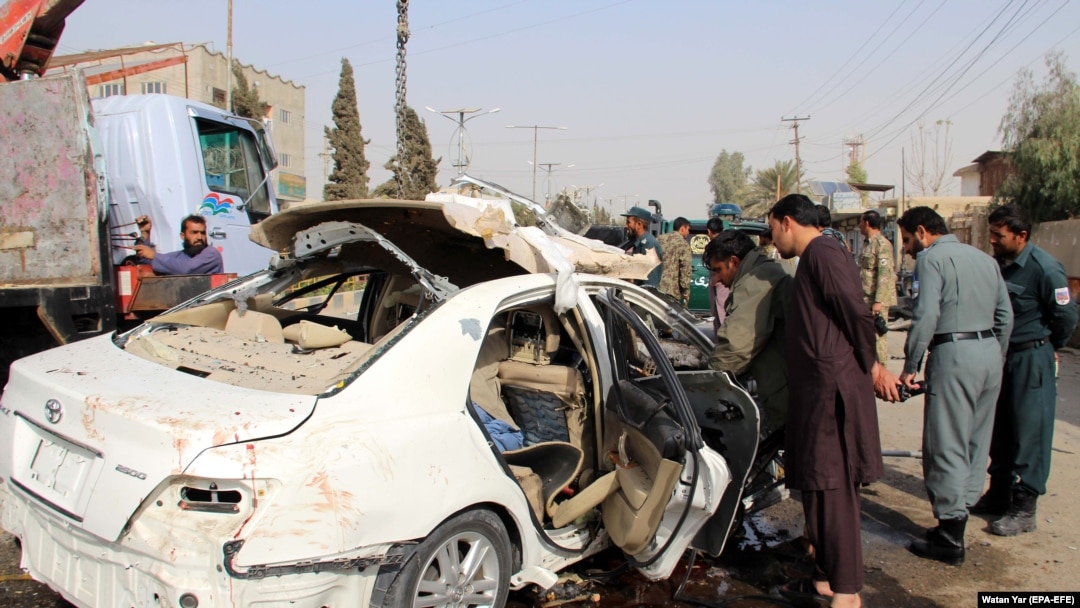A surge of targeted killings and assassinations has swept Afghanistan, where violence has soared despite peace efforts aimed at ending the war.
Many of those being targeted are civilians -- journalists, rights activists, cultural figures, moderate religious leaders, and women in public roles.
The latest victim was RFE/RL journalist Mohammad Ilyas Dayee, who was killed on November 12 when a magnetic bomb placed on his car detonated.
Three others, including Dayee’s brother, a former journalist for German state broadcaster Deutsche Welle, were wounded in the explosion in the southern city of Lashkar Gah.
SEE ALSO: Obituary: Mohammad Ilyas Dayee, A Narrator Of Afghan Hope And SufferingRights groups say the killings are intended to silence and intimidate independent voices and civil society in Afghanistan, which has made inroads on women’s rights and free speech since the U.S.-led invasion in 2001 toppled the fundamentalist Taliban regime.
Most of the targeted killings have gone unclaimed. The Taliban has denied involvement in many cases. But Afghan officials and observers have blamed the militants.
‘Chilling Effect’
Dayee was the second journalist to be killed in less than a week.
Yama Siawash, a former presenter on Afghanistan’s TOLO TV, was killed in a similar attack in the capital, Kabul, on November 7. A magnetic bomb attached to his car exploded, killing the journalist and two others.
Taliban and Islamic State (IS) militants have threatened and deliberately targeted major TV and radio stations and their staff members, carrying out attacks that have killed dozens of journalists and media employees in recent years.
The attacks have made Afghanistan one of the deadliest countries in the world for journalists and forced media companies to adopt new security measures.
“It’s a chilling message for all members of the media in Afghanistan,” said Patricia Gossman, a senior researcher on Afghanistan at Human Rights Watch (HRW). “This is part of a pattern of increased threats and attacks on journalists.”
SEE ALSO: Afghanistan, Pakistan Singled Out For 'Entrenched' Impunity In Killings Of JournalistsDayee reported on southern Afghanistan, a volatile region that is a stronghold of the Taliban.
“Reporters and other civilians in Taliban-held areas have long expressed fear of retaliation if they complain about the way the Taliban carry out military operations or enforce restrictions,” added Gossman.
Dayee’s death takes to at least four the number of journalists and media workers killed in Afghanistan this year.
Journalist Mir Wahed Shah and technician Shafiq Amiri -- employees of the private Khurshid TV -- were killed in Kabul on May 30 when a bomb blast targeted a minibus carrying employees of the local television station.
The Afghan Journalists Safety Committee reported five journalists were killed in 2019. The media freedom group Reporters Without Borders said 15 Afghan journalists were killed in 2018, the deadliest year ever for the Afghan media.
‘Environment Of Fear’
The Afghanistan Independent Human Rights Commission (AIHRC) said last month that 533 people had been killed and 412 wounded in targeted assassinations in the first six months of the year.
"[There is] news about targeted attacks on activists, government officials, religious scholars, and other civilians every day,” said Shaharzad Akbar, the head of the AIHRC.
“This has created an environment of anxiety and fear at a time when we most need to engage, mobilize, raise our voices, and shape our peace process.”
SEE ALSO: Afghan Journalist Braved Great Dangers On Helmand Front LineIn a report published in October, the United Nations Assistance Mission in Afghanistan (UNAMA) said it was concerned by the increasing number of attacks “deliberately targeting civilians, including education, health and humanitarian workers, members of the judiciary, tribal elders, religious leaders, and civilian government employees.”
UNAMA said at least 2,117 civilians were killed and 3,822 injured from January 1 to September 30 this year. It said that targeted killings accounted for 16 percent of all the civilian casualties.
Among the victims were the well-known religious scholars Maulvi Mohammad Ayaz Niazi and Maulvi Azizullah Mufleh, who were killed in two separate attacks in Kabul in June.
Human rights activist Fatima Khalil was killed along with her driver in a bomb blast in Kabul in June.
The surge in targeted killings comes despite ongoing peace talks between Afghan government representatives and the Taliban aimed at ending the 19-year war.
Afghan and Taliban negotiators have been deadlocked at the negotiating table since the historic talks started in September, unable even to agree on a framework and agenda for negotiations over a permanent cease-fire and a power-sharing formula.
The Taliban has pursued a fight and talk strategy, hoping to gain leverage in talks with gains on the battlefield. But its relentless attacks that are killing scores of Afghans every week have sapped the fragile trust between the sides -- and even endangered the continuation of the negotiations.


